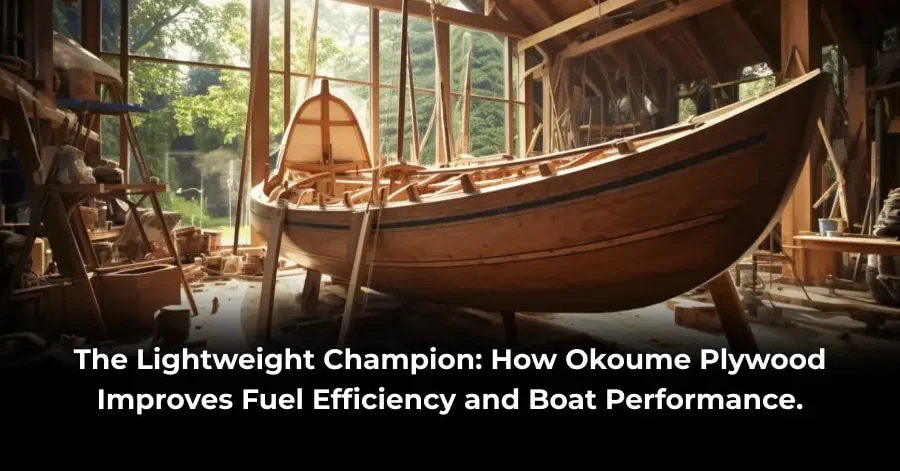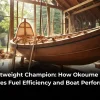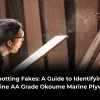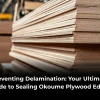There’s a moment, just after you push the throttle forward, that defines the entire boating experience. It’s the split second where the hull transitions from plowing through the water to gracefully planing on its surface. For a passionate boatbuilder or a discerning enthusiast, this moment is pure magic. But what if you could make that moment happen faster, smoother, and with less effort from your engine? The secret doesn’t always lie in a more powerful motor; often, it’s hidden in the very bones of the vessel. This is where the story of Okoume plywood begins—a story of unparalleled strength, remarkable lightness, and the pursuit of nautical perfection.
For anyone who has spent time in a woodworking supplies store or a boatyard, the name Okoume marine plywood carries a certain reverence. It’s not just another sheet of wood; it’s a carefully engineered material that has revolutionized how we build performance-oriented boats. This isn’t a tale of cold, composite plastics or heavy, traditional timbers. It’s about a beautiful, sustainable wood from the Gabon forests of West Africa that, when crafted into premium Okoume plywood, becomes the undisputed lightweight champion of the marine world.
Why Weight is the Ultimate Adversary on the Water
To understand the brilliance of Okoume marine plywood, we must first appreciate the constant battle against weight. In boat design, every single pound matters. A heavier boat requires more energy to get moving (a concept known as “getting on plane”), more power to maintain speed, and more fuel to cover the same distance. It’s simple physics: mass is the enemy of acceleration and efficiency.
Imagine pushing a heavily laden wheelbarrow versus an empty one. The difference in effort is dramatic. Now, translate that to your boat’s engine. A hull built from heavier materials forces the engine to work significantly harder, leading to increased fuel consumption, higher emissions, and more strain on the entire drivetrain. This is the fundamental problem that Okoume plywood was born to solve. By choosing a lighter core material, you are fundamentally changing the boat’s relationship with the water and its engine, setting the stage for superior performance from the keel up.
Meet Okoume: The African Gem
Okoume (pronounced oh-KOO-may) comes from the Aucoumea Klaineana tree. For generations, its fine, straight grain and beautiful pinkish-brown hue have made it a favorite for cabinetry and veneers. But its true calling is on the water. The wood itself is naturally less dense than many traditional boatbuilding hardwoods like mahogany or teak. This intrinsic lightness is the first half of its superpower.
The second half is how it’s transformed into Okoume marine plywood. This isn’t your standard hardware store plywood. Authentic Okoume marine plywood is manufactured with meticulous care. The veneers are peeled from selected logs and cross-banded—layered with each ply’s grain perpendicular to the next. This construction method distributes strength evenly across the entire sheet, eliminating weak points and preventing the panel from splitting. The layers are then bonded with waterproof, boil-proof (WBP) phenolic resins. This glue line is permanent; it won’t delaminate when subjected to constant immersion, humidity, or the occasional pounding of waves. When you source this material from a reputable woodworking supplies store, you are not just buying wood; you are investing in a proven marine-grade component.
The Direct Link: Lightness Equals Efficiency and Performance
So, how exactly does a sheet of Okoume plywood translate to better fuel economy and a more thrilling ride? Let’s break it down.
- Quicker to Plane: The most immediate sensation you’ll notice with a boat built from Okoume plywood is its rapid acceleration. Because the hull is lighter, the engine doesn’t have to labor as hard to push the boat up and over its own bow wave. It gets “on plane” faster. This initial burst is not just fun; it’s efficient. An engine that reaches its optimal RPM range quickly spends less time in a fuel-guzzling, low-speed struggle.
- Reduced Fuel Consumption: This is the most tangible financial benefit. Once on plane, a lighter boat requires less power to maintain speed. Your engine can operate at a lower, more efficient RPM to achieve the same cruising speed as a heavier counterpart. Over a long day on the water, a season of fishing, or a multi-day cruise, these savings compound dramatically. You’ll find yourself visiting the fuel dock less often and spending more of your budget on adventures instead of gasoline. This direct improvement in miles per gallon is a core reason why performance builders insist on Okoume marine plywood.
- Enhanced Handling and Agility: A lightweight hull is a nimble hull. It responds more instantly to the helm, banks into turns with less inertia, and cuts through choppy water with greater ease. The reduced mass makes the boat feel more alive and connected to the water and the driver. For sailboats, a lighter hull means less wetted surface area when heeled over, reducing drag and potentially increasing speed. This performance edge is critical for racers and anyone who values a responsive, spirited craft.
- Increased Payload Capacity: Think of the total weight of your boat as a budget. You have a maximum capacity. If the hull itself is heavy, you’ve already spent a large portion of that budget before you’ve even added passengers, gear, coolers, and fuel. By building the hull with lightweight Okoume plywood, you “save” a significant amount of weight, which can then be allocated to carrying more people, more fishing equipment, or longer-range fuel tanks without sacrificing performance or safety.
Sourcing Your Champion: The Importance of a Specialized Woodworking Supplies Store
Not all marine plywood is created equal, and not every retailer understands the specific needs of a boatbuilder. This is why your choice of a woodworking supplies store is critical. You need a supplier that doesn’t just stock wood but understands its application. A specialized woodworking supplies store will offer premium Okoume plywood that is certified for marine use, free of core voids that can create soft spots, and supplied with perfectly sanded faces for a flawless finish.
They will be able to advise on sheet sizes, thicknesses, and the best accompanying epoxies and fiberglass cloths to complete your project. Building a relationship with a knowledgeable supplier is as important as selecting the material itself. They become a partner in your project, ensuring you get the quality you need for a build that will last for decades.
Also Read- How to Maintain and Protect Okoume Marine Plywood for Longevity
Beyond the Scale: The Other Virtues of Okoume
While its weight is the headline, Okoume plywood has other qualities that make it a joy to work with. Its fine, uniform grain is exceptionally easy to cut and sand, making it a favorite among amateur and professional builders alike. It bends beautifully under steam or with kerf-cutting, allowing for the creation of elegant, complex curves in a hull. When sealed correctly with epoxy and fiberglass, it forms a monolithic, durable structure that is incredibly strong for its weight and highly resistant to rot. It’s the complete package: easy to work with, beautiful to finish, and incredibly durable in its final, encapsulated form.
AEW Wood: Your Trusted Partner for Premium Marine Plywood
When embarking on a project where quality is non-negotiable, the source of your materials matters immensely. This is where a company like AEW Wood shines. AEW Wood has built a reputation as a leading supplier of top-tier marine-grade plywoods, including the finest Okoume plywood available on the market. They understand the critical demands of boatbuilding and provide products that meet the highest standards of consistency, finish, and structural integrity. For builders who will not compromise on the core of their craft, sourcing from a dedicated specialist like AEW Wood ensures that the “lightweight champion” at the heart of your boat is a true titleholder, ready to deliver a lifetime of efficient and exhilarating performance.
Conclusion
In the world of boatbuilding, every choice has a consequence. The decision of what material forms the heart of your hull is the most significant one you will make. Okoume plywood is not merely an option; it is a strategic choice for efficiency, performance, and elegance. It is the material that understands the ancient mariner’s dream—to travel farther, faster, and with less effort. By embracing the lightweight champion, you are not just building a boat; you are engineering an experience defined by responsive handling, reduced fuel costs, and that perfect, effortless moment when your craft rises to meet the horizon. Visit a specialist woodworking supplies store, ask for genuine Okoume marine plywood, and feel the difference that true performance craftsmanship can make.
Frequently Asked Questions (FAQs)
- Is Okoume plywood resistant to rot and marine borers?
On its own, the Okoume wood is not highly rot-resistant like teak. However, when used correctly as Okoume marine plywood, it is always fully encapsulated in epoxy resin and sheathed in fiberglass. This protective shell completely seals the wood from water and oxygen, making it highly durable and resistant to rot. The encapsulation also protects it from marine borers. - Can I use Okoume plywood for outdoor furniture or other non-marine projects?
Absolutely! While it’s a superstar in boatbuilding, its light weight, stability, and beautiful finish make it an excellent choice for high-end outdoor furniture, cabinetry, and architectural millwork where weight and appearance are important. Just ensure it is properly finished and sealed for its specific environment. - How does the cost of Okoume compare to other marine plywoods like Meranti?
Okoume plywood is typically more expensive than heavier alternatives like Meranti. This initial investment, however, is offset by the performance benefits. The fuel savings over the life of the boat, the increased payload capacity, and the enhanced handling provide a significant return on investment, making it a cost-effective choice for performance-conscious builders. - What thickness of Okoume marine plywood should I use for my boat?
The correct thickness depends entirely on the boat’s design, size, and structural requirements. It is crucial to follow the specifications of your boat plans or consult with a naval architect. A knowledgeable woodworking supplies store or a specialist like AEW Wood can offer guidance based on proven applications. - I’m a first-time boat builder. Is Okoume plywood easy to work with?
Yes, one of the great advantages of Okoume marine plywood is its workability. It cuts cleanly, sands smoothly, and bends more easily than many denser hardwoods. This makes it a very forgiving and rewarding material for amateur builders tackling stitch-and-glue or other plywood-based boatbuilding methods.






